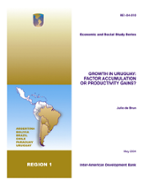Growth in Uruguay: Factor Accumulation or Productivity Gains?
Date
May 2004
This paper is part of the project "Explaining Economic Growth Performance" launched by the Global Development Network (GDN). The purpose of this project is to explain economic growth performances across seven regions. During the last five decades the Uruguayan economy faced volatile macroeconomic conditions. Economic policies swung from highly controlled capital flows, exchange rates, and interest rates to the introduction of significant financial liberalization. This study will show that the upturn in economic growth since liberalization is due to improved resource allocation that, in turn, promoted an increase in human capital accumulation. No significant changes are observed in the pattern of physical capital accumulation or the evolution of Total Factor Productivity (TFP). The analysis begins with an overview of recent economic policy in Uruguay, summarizing the characteristics of each period. A growth accounting exercise is then conducted to begin weighing which factors are crucial to understanding the country's pattern of growth. This exercise will show, as previously stated, that TFP played a minimal role. This evidence is complemented by analysis of a time series of key variables, which permits us to address the empirical regularities that must be explained to understand economic growth in Uruguay.



